Why kites fly
LIFT, DRAG, AND GRAVITY:
A kite and airplanes are heavier-than-air object that are flown by the lift created by air in motion over their wings. An airplane relies on thrust from its engines. A kite is tethered in place and needs moving air (wind) to fly.
There are many possible kite shapes. Each of these shapes, and how they use their aerodynamic features (either built in or added on) will determine if or how it flies.
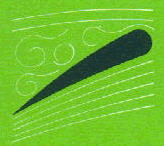
Wind moving across the sail of a kite creates pressure. Lift results from this wind pressure being deflected along the face of the kite. In other words, the wind pushes up on the kite. Think of wind pressure like a hand, pushing the kite up into the sky and holding it there. If the hand is removed, the kite will fall.
At the same time, wind passing over the top of the kite creates an area of low pressure, like a vacuum, along the back of the kite. This creates a pull from behind.
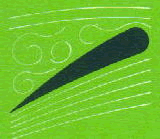
A kite is effected by thrust, drag and by gravity.
Drag is created by wind resistance on the kite’s surface (and tail). Drag can also result from turbulence behind the kite. Gravity is the downward force created by the weight of the kite. Thrust is the power of the wind which creates lift.
To fly, a kite needs to have enough lift to overcome gravity and drag.
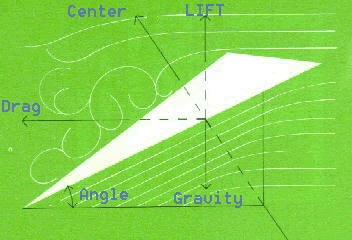
All of these forces – lift, drag, gravity, and the thrust of the wind come together in the kite at a place called the center of pressure . And not surprisingly, that’s where you tie your kite string. We call this special place the tow point.
By moving the pace your string is attached to the kite on the bridle line, you can change the amount of lift that is created. You do this by changing what we call the angle of attack . This is the angle that the kite leans into the wind.
DIHEDRAL:
The one other thing that is important in understanding flight is something called dihedral . This is a special word from geometry that describes the angle formed when two wings come together.

The dihedral angle of a kites wings helps the kite fly smoothly. If the wings lean back at the same angle, then the wind pushes equally on both wings. If one side of the kite begins to turn further into the wind, then the wind will push harder on that side until the kite becomes stable again. So with a proper dihedral angle built into the kite’s design, it will fly properly balanced in the sky. We call that equilibrium.
FLIGHT STABILITY:
Properly balancing the dihedral of the kite, the tow point of the bridle, and even a varying amount of tail will affect the stability of your kite along the vertical (yaw), lateral (pitch) and longitudinal (roll) axes.
Yaw is the rotating action about a kite’s vertical axis. This is the imaginary line that goes from the ground up through the kite into the sky. The kite turns to the right or left, just like an airplane turns from the right or the left as you watch it from the ground.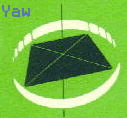
If the tow point is too far forward, or if the kite is not properly balanced, it may start sliding or rotating. To correct the problem:
- Try moving the tow point back
- Check the kite for balance
- Try adding tail (drag at the bottom of the kite
| Pitch is the rotating action about a kite’s lateral axis. This is another imaginary line. On an airplane, you can think of the wings as the lateral axis. If a kite has a poor bridle, or inadequate sticks, the wind can distort its shape and create a flapping or pitching motion. | 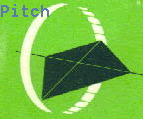 |
To correct the problem:
- Add more bridle lines to balance the wind pressure around the kite
- Use stronger sticks
| Roll is the rotating action about a kite’s longitudinal axis. On an airplane, this would be the imaginary line through the body or fuselage. When an airplane, or kite, rolls, one wing lifts higher and the other is lowered.
A flat kite will be unstable and will tend to dip to one side or the other to reduce pressure on the sails. To correct the problem: |
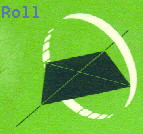 |
- Move the tow point forward
- Add more tail to the kite
- Bow the kite to create a dihedral
